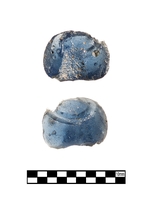Document Content
Daily Log
June 23, 2003
AM
Southern Terrace 1 was cleaned of loose dirt in the morning. Then the two remaining 2.5 by 2.5 m areas were pick axed. Although the light-colored soil does appear in some areas, it does not appear in others at the same elevation, suggesting an irregular contour. Our primary goal for the next few days is to define the Locus 3 soil for a clear picture of what is going on in the area and to see if there are any postholes. Among the finds this morning were a few pieces of unusually shaped terracotta, three sling stones, in different areas of the trench, and most notably a piece of . There appears to be a fresh break on one edge, but a search of the surrounding soil produced no results. Excavation this morning also produced a larger quantity of ceramic and
tile than usual.
PM
A couple more pick passes were made in the high areas, but there is still only a few spots of white soil in some areas. We did not expose all of Locus 3 today. More sling stones were found, along with a freshly broken piece of inscribed terracotta.
A hypothetical theory that seems rational about the stratigraphy of this area is that the white soil in ST1 and T28 north and south is actually gylestra, and also the ancient, undisturbed topsoil for the Etruscans. The only artifacts that have come out of this soil in the T28 area are the "sling stones" and the tile from the fossa. It seems likely that when the fossa was made, the trench cut through the gylestra. After it was filled with tile, either human actors or erosion brought the white soil
down on top of it. The "sling stones" can be explained by their relationship to a soft flaky rock found within the gylestra. It does not seem unrealistic that "sling stones" break off in this unusual fashion from this rock.
This hypothesis is supported by the large amount of artifacts that have been found in the lower levels of Locus 3; possibly the layer that rests directly over the old topsoil of the area.
FINDS
Locus 2:
- 629 pieces of terracotta (1 bucket)*
- 91 ceramic fragments (1 latte box)
- 5 sling stones (Finds , , , , and )
- 3 unusual terracotta fragments (Finds , , and )
- 1 piece of inscribed terracotta ( )
- E 195.77 S 92.70
- elev. 22.18
- 1 piece of cobalt blue glass
-
*Bucket measures 29 cm high, and 25 cm in diameter at the top.
| Descriptive Attribute | Value(s) |
|---|---|
| Document Type | Trench Book Entry |
| Trench Book Entry Date | 2003-06-23 |
| Entry Year | 2003 |
| Start Page | 48 |
| End Page | 59 |
| Title | Daily Log |
| Field Tile Count | 629 |
| Ceramic Count (Note) | 91 |
| Descriptive Attribute | Value(s) |
|---|---|
|
Is Part Of
Vocabulary: DCMI Metadata Terms (Dublin Core Terms) |
RWWI
Vocabulary: Murlo |
Suggested Citation
Robert Wanner. (2017) "RWWI (2003-06-23):48-59; Daily Log from Europe/Italy/Poggio Civitate/Tesoro South Terrace/Tesoro South Terrace 1/2003, ID:505/Locus 2". In Murlo. Anthony Tuck (Ed). Released: 2017-10-04. Open Context. <https://opencontext.org/documents/e1dbbb8d-5c86-43c3-b3ab-d373fc351531> ARK (Archive): https://n2t.net/ark:/28722/k20s02f82
Copyright License
To the extent to which copyright applies, this content
carries the above license. Follow the link to understand specific permissions
and requirements.
Required Attribution: Citation and reference of URIs (hyperlinks)







